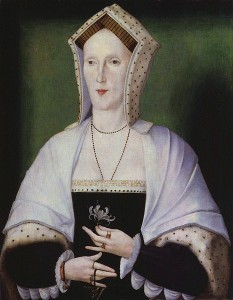 Margaret Pole, or Margaret Plantagenet, was the daughter of George, Duke of Clarence - brother of two Plantagenet kings: Edward IV and Richard III - and his wife Lady Isabella Neville, daughter of Richard Neville, 16th Earl of Warwick and a man known as 'the Kingmaker'. Margaret was born on 14th August 1473 at Farley Castle, near Bath. She married Sir Richard Pole in 1491, having five children before she was widowed in 1505. One of her children was Reginald Pole who became a cardinal and then Archbishop of Canterbury during the reign of Mary I.
Margaret Pole, or Margaret Plantagenet, was the daughter of George, Duke of Clarence - brother of two Plantagenet kings: Edward IV and Richard III - and his wife Lady Isabella Neville, daughter of Richard Neville, 16th Earl of Warwick and a man known as 'the Kingmaker'. Margaret was born on 14th August 1473 at Farley Castle, near Bath. She married Sir Richard Pole in 1491, having five children before she was widowed in 1505. One of her children was Reginald Pole who became a cardinal and then Archbishop of Canterbury during the reign of Mary I.
At the beginning of King Henry VIII's reign, Margaret was very much in favour. The King allowed her to become the 8th Countess of Salisbury and she was his daughter Mary's godmother and governess. However, things went rather pear-shaped when Margaret's son, Reginald Pole, spoke out against the King's annulment of his marriage to Catherine of Aragon. Things got even worse when Reginald Pole published Pro ecclesiasticae unitatis defensione, which denounced Henry VIII's policies. This brazen insult to the King made Henry want to wreak his revenge on the Pole family and the situation was not helped by the Countess of Salisbury's Plantagenet blood, which Henry VIII also saw as a threat.
In November 1538, various members of the Pole family were arrested for treason and taken to the Tower of London. In January 1539, many of them were executed. Even though the Countess was elderly (for Tudor times), being 65 years of age in 1538, she was questioned and taken to Cowdray House near Midhurst. In May 1539 a bill of attainder was issued against her by Thomas Cromwell and a tunic displaying the Five Wounds, which was used as a symbol in the Northern rebellions, was used as evidence against her, having allegedly been found in her belongings. She was stripped of her titles and imprisoned in the Tower of London.
After two years of being imprisoned as a traitor in the Tower, the frail 67 year-old Plantagenet heiress was executed on 27th May 1541. As a woman of noble birth, Margaret Pole was given a private execution. There are two accounts of her execution – One says that she was executed by an inexperienced axeman who missed her neck the first time, gashing her shoulder, and that it took a further ten blows to finish her off. The second account tells of how she managed to escape from the block and that she was hewn down by the executioner as she ran. This second account concurs with the first in that it says that eleven blows were required. Whichever account you believe, this lady had a truly awful end.
On the 29th December 1886, Pope Leo XIII beatified Margaret, making her Blessed Margaret Pole, a Catholic martyr. Her feast day is the 28th May, the date that some sources give as her execution date.
These are the words found on the wall of her cell and which are said to have been etched there by Margaret:
For traitors on the block should die;
I am no traitor, no, not I!
My faithfulness stands fast and so,
Towards the block I shall not go!
Nor make one step, as you shall see;
Christ in Thy Mercy, save Thou me!
Further Reading
- Margaret Pole, Countess of Salisbury 1473-1541: Loyalty, Lineage and Leadership by Hazel Pierce, University of Wales Press, 2009.
- Margaret Pole: The Countess in the Tower by Susan Higginbotham, due out August 2015, Amberley Publishing.



I have always felt that Margaret’s death was a travesty of justice. It was just a sadistic and spiteful act of a tyrannical coward.
I completely agree. When Henry couldn’t get the true aim of his anger, her middle son, Cardinal Reginald Pole who wrote a treatise against the divorce from Katherine which offended him, of course, he went for both her other sons and then Margaret, herself, who had done nothing and didn’t even know why she was being executed. Young Katherine Howard had shown kindness to Margaret while she was in the Tower and the poor old lady was then taken out and educated in a tyrannical move. Why the timing? There had been widespread unrest and further trouble from abroad making the Tudor Government nervous. Henry and his new Queen were about to set off on their Northern progress and Henry ordered the prisoners in the Tower removed ( that is those considered dangerous executed) as house cleaning. That at least was his excuse. He had waited two years and he obviously felt he needed an excuse, even though in reality he just got rid of the last of a rival family the Tudors had been trying to wipe out for two generations.
Margaret had indeed been a great friend of Katherine of Aragon and King Henry and the Governess of Princess Mary, to whom she was close for many years. Since the Supremacy, although the Pole family had sworn the oath, they had remained under watch as to their loyalty. The writing of Reginald on the Continent and his encouragement of the rebels in the Pilgrimage of Grace had sent Henry’s agents to capture him but they had failed. Now with more threats as Henry saw it and his henchman, Cromwell, seeing reds under the bed, or traitors in every corner heard a casual remark and a letter from Henry Pole to his brother, saying that if Henry fell foul of his leg there would be a great change in England, he was arrested and executed. Reginald was still at large and Cromwell himself had long been executed, but nobody could get at the Cardinal. With her son and son in law dead, her grandson and younger son, Geoffrey a prisoner in the Tower, Margaret had been imprisoned ever since. Now in this terrible act, Henry ordered her death as well. Her end was terrible, with many strokes of the axe needed to end her pain. It was purely an act of tyranny.
It must also be remembered that in another controversial move, Henry Tudor, our Henry’s father had executed, out of the blue, the young, but now adult Earl of Warwick, whom he had held as a detainee, then prisoner since 1486. Edward, then aged ten had been in the care first of relatives and retainers in Middleham and Sherrif Hutton before being brought to London and placed in the care of the new King’s mother. Within months Henry Vii thought him dangerous and moved him to detention in the Tower ( we are not talking of a cell but close confinement) although he retained his rank as Earl of Warwick and was on show occasionally. He was led to Mass at Saint Pauls and there encountered his cousin, John de la Pole, Earl of Lincoln, who then vanished only to lead a rebellion that the Government said was in Warwick’s name. The Lambert Simnel affair as we know of it was probably a rouse as Lincoln would not have followed a fake or anyone less than the son of Edward iv. It is more likely that the trouble in 1486/7 was in the name of someone believed to be Edward V than Warwick as the contemporary sources indicate, although many are very confused on the matter. The official Government version can’t be trusted.
Henry had young Warwick, the brother of our Margaret Pole executed on trumped up charges when he disposed of another young Pretender, Richard of England or Perkin Warbeck as the Government called him, who claimed to be Richard, Duke of York, younger son of Edward iv, who caused Henry Vii numerous problems between 1493 and 1497. Having captured the latter and given him the run of the palace, he was allowed to escape. Being recaptured, badly beaten in his face and forced into a false confession, according to Wroe and others, Warbeck was housed in the Tower with Warwick, sometimes next door, sometimes together. Under orders from Spain to get rid of these problems, Henry set both of them up in 1499 to conspire and escape. Recaptured and again beaten, Warbeck was tried and publicly forced into another “confession” and hung as a felon. Warwick was tried as well and beheaded the next day at the Tower in November 1499. Margaret, of course had been married off and was compliant with the Tudor regime, yet must have felt anger and sorrow at the judicial murder of her brother. Henry saw the young man as a threat who could be used by others and the Warbeck affair was his excuse to get rid of a potential rival. It has been seen also as tyranny, but could it be more accurate to say it was out of fear and desperation to protect his crown and family and fragile reign or was he placating the Spanish? The alliance and marriage to Katherine of Aragon, Infanta of Spain with the English heir, Prince Arthur was under threat by these claimants and so was the peace and security of the realm. It is highly unlikely that Warwick was any real threat, but Henry wasn’t taking any more chances.
Margaret and Edward of Warwick were of course the son and daughter of George, Duke of Clarence, brother to both Edward iv and the future Richard iii and so technically in line to the Plantagenet House of York. George had also been recognised as the heir to the House of Lancaster and his children after him. However, he was a nuisance and led several rebellious actions against his brother, King Edward along with Richard Neville, Earl of Warwick, the Kingmaker. Finally, a few years after his last reconciliation with his brother, in 1477, Clarence lost the plot and having just lost his wife in childbirth, had two people hung as poisoners and witches. He had also put it about that his brother was illegitimate and his children illegitimate. He was arrested, tried and found guilty of treason. On the probable insistence of Elizabeth Woodville he was executed on 18th February 1478 most probably by drowning in a large barrel of wine. He was buried in the Clarence vault in Tewkesbury Abbey. However, he was also attainted and his children barred from succession to the crown. Such a legal action could be reversed and Henry Tudor had a fragile hold on the crown himself. He was understandably nervous of rival families. Margaret was married to a man of lower standing and her brother detained, then imprisoned in the Tower. His execution sent a clear message that the Tudors were here to stay. Margaret would give long and loyal service to Katherine of Aragon and Henry Viii and her execution because of the foolish actions of her son, Reginald was tragic and needless and showed desperation yet again.